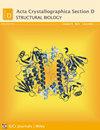人肌营养不良蛋白串联钙钙蛋白同源肌动蛋白结合结构域结晶为闭态构象。
IF 3.8
4区 生物学
Q2 BIOCHEMICAL RESEARCH METHODS
Acta Crystallographica. Section D, Structural Biology
Pub Date : 2025-03-01
Epub Date: 2025-02-26
DOI:10.1107/S2059798325001457
引用次数: 0
摘要
以1.94 Å分辨率测定了人肌营养不良蛋白n端肌动蛋白结合域的结构。不对称单元中的每个链以“封闭”构象存在,第一和第二钙钙蛋白同源(CH)结构域通过2500.6 Å2接口直接相互作用。单个CH结构域的定位与先前在人类肌营养不良蛋白和肌营养蛋白肌动蛋白结合结构域1结构中看到的结构域交换二聚体相似。CH1结构域与肌动蛋白结合的肌营养蛋白结构高度相似,结构同源性表明,在肌动蛋白结合过程中,封闭的单链构象打开,以减轻CH2和肌动蛋白之间的空间冲突。本文章由计算机程序翻译,如有差异,请以英文原文为准。
Human dystrophin tandem calponin homology actin-binding domain crystallized in a closed-state conformation.
The structure of the N-terminal actin-binding domain of human dystrophin was determined at 1.94 Å resolution. Each chain in the asymmetric unit exists in a `closed' conformation, with the first and second calponin homology (CH) domains directly interacting via a 2500.6 Å2 interface. The positioning of the individual CH domains is comparable to the domain-swapped dimer seen in previous human dystrophin and utrophin actin-binding domain 1 structures. The CH1 domain is highly similar to the actin-bound utrophin structure and structural homology suggests that the `closed' single-chain conformation opens during actin binding to mitigate steric clashes between CH2 and actin.
求助全文
通过发布文献求助,成功后即可免费获取论文全文。
去求助
来源期刊

Acta Crystallographica. Section D, Structural Biology
BIOCHEMICAL RESEARCH METHODSBIOCHEMISTRY &-BIOCHEMISTRY & MOLECULAR BIOLOGY
CiteScore
4.50
自引率
13.60%
发文量
216
期刊介绍:
Acta Crystallographica Section D welcomes the submission of articles covering any aspect of structural biology, with a particular emphasis on the structures of biological macromolecules or the methods used to determine them.
Reports on new structures of biological importance may address the smallest macromolecules to the largest complex molecular machines. These structures may have been determined using any structural biology technique including crystallography, NMR, cryoEM and/or other techniques. The key criterion is that such articles must present significant new insights into biological, chemical or medical sciences. The inclusion of complementary data that support the conclusions drawn from the structural studies (such as binding studies, mass spectrometry, enzyme assays, or analysis of mutants or other modified forms of biological macromolecule) is encouraged.
Methods articles may include new approaches to any aspect of biological structure determination or structure analysis but will only be accepted where they focus on new methods that are demonstrated to be of general applicability and importance to structural biology. Articles describing particularly difficult problems in structural biology are also welcomed, if the analysis would provide useful insights to others facing similar problems.
 求助内容:
求助内容: 应助结果提醒方式:
应助结果提醒方式:


